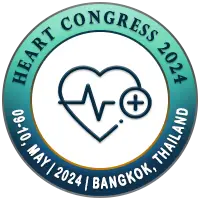
Kiriena Boldyreva
Bakoulev National Medical Research Center for Cardiovascular Surgery, Russian FederationTitle: Dual-energy dynamic myocardial perfusion imaging in patients with obstructive coronary artery disease
Abstract
Objective: to evaluate the accurate assessment of global and regional myocardial blood flow obtained by dynamic myocardial computed tomography perfusion (CTP) with a pharmacological load (PL) in patients with hemodynamically significant coronary artery (CA) stenosis.
Material and methods: In total 34 patients (15 women and 19 men, the median age 62(60;70.8)y.o.) with suspected stable CAD were eligible for the study. All patients underwent invasive coronary angiography (ICA), and then (within 8 months) dynamic CTP and coronary CTA on a dual-source CT scanner (SOMATOM Force, Siemens Healthineers). 102 coronary regions (CR) were assessed on the Syngo.via workstation using qualitative and quantitative methods. CR were divided into 4 groups: 1st- control group (n=53), 2d- group with CA stenosis >50% (n=49); 3d-group with CA stenosis 0-69% (n=84) and 4th-group with CA stenosis >70% (n=18). The main quantitative parameters were: stress myocardial blood flow (sMBF) and myocardial blood volume (MBV) at the global and regional levels.
Results: The association between the perfusion parameters (sMBF) and CA stenosis degree was revealed: rho = - 0.34 (p<0.001). A significant difference was obtained in the regional parameters of the sMBF between the 1st and 2d groups (p<0.001); 3d and 4th groups (p<0.001). The optimal sMBF threshold for identifying CA stenoses >50% was 135 ml/100 ml/min (AUC=0.719; p<0.001) with sensitivity, specificity, positive (PPV) and negative predictive value (NPV) of 71%, 62%, 63% and 70%, respectively; to identify >70% stenoses: 126ml/100ml/min (AUC=0.756; p<0.001), (72%, 70%, 34% and 92%).
Conclusion: Regional sMBF is more informative than global on in obstructive coronary artery disease detection. The sMBF cut-off values for identifying CA stenosis >50% and >70% have a good combination of sensitivity, specificity. Dynamic CTP has an increscent diagnostic value over coronary CTA alone for the identification of hemodynamically significant coronary artery disease.
Biography
Kiriena Boldyreva is working on PhD according her abstract topic. She has been studying coronary heart disease radiology for 5 years. Annually attend all the Russian cardiovascular radiology Congresses with almost oral presentations. She has more than 10 publications. Member of ECR, Russian Radiology Society.

